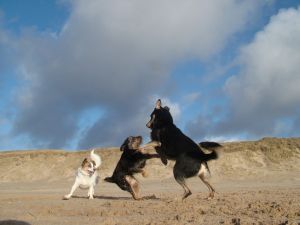Most pet owners know how to tell if their dog is happy and healthy. He will have a shiny, healthy coat, eager to play, and have regular eating and elimination habits. Signs of a sick dog are not always so easy to spot. Dogs have a natural instinct to hide sickness; in the wild, sick animals who show signs of sickness or weakness are likely prey for other animals. Many symptoms of illness are vague, but knowing the warning signs to watch for and knowing when to call the veterinarian can keep illnesses from becoming more severe. Symptoms may indicate a variety of illnesses; diagnosis often requires the use of X-rays and blood tests. Treating illnesses early can prevent costly vet bills and even save the life of a beloved pet.
Refusing to eat is one of the first warning signs of illness. In the hot summer months, dogs may eat less, or occasionally skip a meal, which is not cause for concern, but a dog who refuses to eat for more than two days should be examined by a vet.
The normal body temperature for newborn puppies is 94-97 degrees F, and at four weeks will reach 101.5, which is the normal adult dog temperature. A dog with a fever above 105 or temperature lower than 96 should be seen by a vet immediately.
Vomiting is the most common symptom, and can indicate a variety of problems: food allergies, parasites, intestinal disorders, poisoning, diabetes, kidney disease. Occasional vomiting may just mean the dog ate something that didn’t agree with him, but frequent or consistent vomiting should be checked out, especially if the dog is also has a fever with diarrhea and is losing weight.
Dogs do not normally drink a great amount of water, although they will drink more when the weather is hot. Excessive thirst can be a symptom of diabetes or kidney disease. They may start having accidents in the house. It is good practice to be aware of your dog’s elimination habits, how much he goes and what his urine and stools look like. Normal stools will be soft but well-formed, and may occasionally contain small amounts of mucous or blood. Any changes in his habits may indicate a health problem. Diarrhea is another common symptom. It can be caused by something as simple as a change in diet, or can be a symptom of parasites, bowel disorders, or an undiagnosed metabolic disease. Occasional diarrhea is not cause for alarm; he may have eaten something that didn’t agree with him again! Any episodes of diarrhea that continue for more than a day or two should be evaluated by a veterinarian. If the dog strains to eliminate, with hard, dry stools, he may not be drinking enough water, or may have other dietary or health problems. Wiggly, white segments indicate worms. Increased frequency of urination, straining during urination, dark urine, or urine with blood in it are signs of trouble.
Dogs don’t have sweat glands, so they cool off by panting. It’s normal for dogs to pant during hot weather or after playing vigorously, but it can also signal that he is in pain or having trouble breathing. If your dog is having trouble breathing, it could be an emergency; call the vet immediately.
If your dog is at his ideal weight, you should be able to feel his ribs but not see them through his coat, and his weight should be consistent once he reaches adulthood. Just as in humans, being overweight can contribute to diabetes and arthritis in dogs. A dog who is too thin or losing weight may be showing signs of disease.
A healthy dog is active and ready to play. Dogs may become lethargic on hot days, or if they are sore after playing too vigorously or taking a long walk, and will naturally slow down as they age. They may want to sleep more. Lethargy can also be a sign of poisoning, however, so any marked reduction in your dog’s activity that lasts more than a day should be evaluated.
Coughing may be a symptom of a virus or infection, or it can indicate heart failure. Have him examined if he coughs frequently. Check your dog’s gums and teeth regularly. Dental infections can cause bad breath, and the infection can spread throughout the dog’s body, causing serious illness or even death. His gums should be pink and firm and his teeth free from tartar.
Your dog’s nose should be free from colored, thickened, crusty, or runny discharges; his eyes should not have any redness, swelling, or discharges. His ears should be free of discharges and odor. Any of these signs would indicate an infection. His coat should be glossy and thick without excessive shedding (keeping in mind that some breeds shed more than others, and dogs will shed more during hot weather). His skin should be free from tumors and sores. Constant scratching and biting at the skin may mean that he is has parasites, a skin infection, allergies, a reaction to a bee sting, or other underlying conditions. Any signs of tumors, infection or excessive itching should be treated by a veterinarian.
A dog in pain will often whine or whimper, and he may have an aggressive change in temperament. He may have a sprain, bruise, or broken bone, and react when you touch the injured area, but unprovoked whining may indicate an internal injury, which can be an emergency. A dog with abdominal pain may stand hunched over, or stand on his hind legs with his forelegs down on the floor.
If your dog is showing any signs of illness, or a change in behavior, keep a record of the dog’s symptoms. It will aid the vet in correctly diagnosing and treating your pet. The following symptoms are signs of a medical emergency and you should call your veterinarian at once:
Pale, blue, or white gums.
Fainting, collapsing, seizures or convulsions.
Heat exhaustion–panting, lethargy, glazed eyes, unsteady gait
Enlarged abdomen–may be a sign of a twisted stomach, heart disease, or infection.
Inability to use his back legs.
Inability to urinate.
Dehydration–pinch the skin at the back of his neck; it should spring back quickly in a healthy dog.






